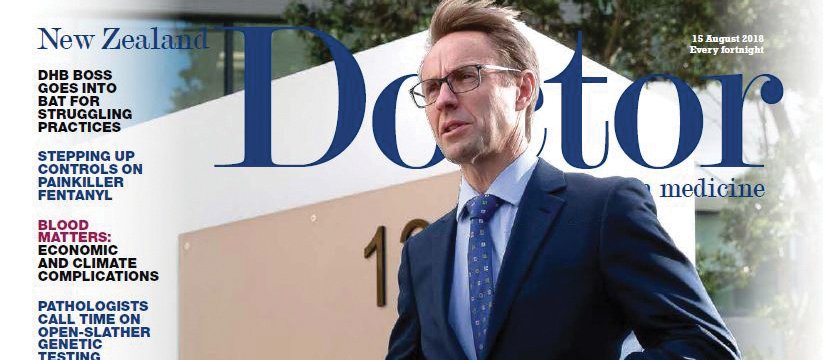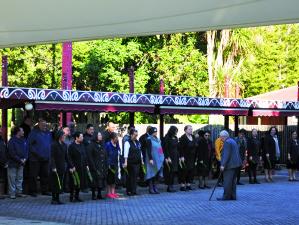Respiratory physician Lutz Beckert considers chronic obstructive pulmonary disease management, including the prevention of COPD, the importance of smoking cessation and pulmonary rehabilitation, and the lifesaving potential of addressing treatable traits. He also discusses the logic of inhaler therapy, moving from single therapy to dual and triple therapy when indicated, as well as other aspects of management
When Ashley quietly seized the day
When Ashley quietly seized the day

Was he the perfect Dr Johnny-on-the-spot when COVID-19 reached an anxious nation? Former director-general of health Ashley Bloomfield is under no illusions there, he tells Virginia McMillan
Ashley Bloomfield says it was by happenstance he was at the helm of the health system when the pandemic struck.
The man who has appeared large as life on tea-towels, T-shirts and TikTok had specialised in public health medicine, examining the social determinants of health as a registrar and later steeping himself in strategy, policy and management.
By the time Dr Bloomfield arrived in the Ministry of Health’s top job, he had a decent service record in the ministry and DHBs. Few public health doctors have had that experience, he says of the road that led him unexpectedly to become the best-known civil servant New Zealand has yet seen, thanks to his long-term commitment to fronting the media about the COVID-19 pandemic.
Retired specialist GP Peter Moodie has in various roles had a close eye on the pandemic response. Dr Moodie is clear that Ashley Bloomfield “was the right person at the right time”.
The response, however, was peppered with administrative delays and problems – with managed isolation and supply of equipment, for instance.
Dr Moodie says Dr Bloomfield’s team at the ministry was not up to their boss’ standard and the issues that emerged would have been the downfall of most chief executives.
Before starting as director-general of health in June 2018, Dr Bloomfield had three years as chief executive of Hutt Valley DHB. He had previously led service integration and population health at Wellington’s three DHBs. In the early 2000s, he headed the National Screening Unit, had about five years as chief advisor public health at the ministry and spent a year in policy at WHO in Geneva.
Says University of Auckland epidemiologist Rod Jackson: “I don’t think we have ever had a director-general with such a wide range of significant experience...I think he did a pretty good job.”
New Zealand Doctor Rata Aotearoa asked Dr Bloomfield what he was proudest of achieving in his latest and most prominent role.
He says he has much to be proud of, but foremost is the New Zealand COVID-19 vaccination programme’s high coverage.
The programme was instrumental “in safely opening up the country while protecting the population”, says Dr Bloomfield.
His aim early on in the pandemic had been to keep the virus out until people were vaccinated, “and then my work on it is done”.
Before the COVID-19 onslaught dominated his job and public persona, he had the health inequities experienced by tangata whenua brought home to him in a very public way, at the Waitangi Tribunal in 2018.
Health Services and Outcomes Kaupapa Māori Inquiry (Wai 2575) claimants testified to the many effects of the Crown’s systematic failure to meet its Te Tiriti o Waitangi obligations to serve Māori in ways that worked for them.
Dr Bloomfield was called to respond. He says he was questioned hard but respectfully.
“It strengthened my resolve to make sure we re-established the Māori health directorate in the ministry.”
The directorate has had “great leadership” from deputy director-general Māori health John Whaanga, who challenged and supported the ministry to strengthen its focus on equity and Māori health, Dr Bloomfield says.
“That stood us in good stead when the pandemic hit…
“We had a lot to learn but, through John, we had established relationships to draw on and get the results.”
He points out early COVID-19 vaccine uptake among Māori and Pacific peoples was equitable for those over 65, the age group that was given priority once border and health workers were vaccinated.
“One of the key reasons we actually took the overall approach of elimination is we knew, based on history and… inequities, the groups that would have been hit hardest would be Māori, Pacific and disabled people…
“Arguably, the main driver of our approach was to protect the vulnerable.”
Ministry records show that, after six months, the vaccination push had ensured 496 in every 1000 Māori people over the age of 65 had had two doses of the vaccine. This exceeded the rate in the non-Māori, non-Pacific community, where coverage in that age band was 424 per 1000.
The approach remains controversial for Waikato health leader Tureiti Moxon, who separately had been a Wai 2575 claimant.
While grateful to Dr Bloomfield for his leadership, Lady Tureiti was disappointed in the Crown’s COVID-19 response overall.
“No one was listening to [those of us who said] Māori are a younger population and vaccination should start there and not with older people,” she says.
The ministry, however, noted at the time: “Seventy-seven per cent of the Māori eligible population and 79 per cent of the Pacific eligible population are under the age of 54. The opportunity for significant numbers of Māori and Pacific people to be vaccinated will not occur until vaccinations start for this age group.”
Dr Bloomfield says the younger age group and the 100,000 or so unenrolled New Zealanders took a lot of work, and targeted funding.
Here, Māori and community providers proved their worth, he says.
Still, a look at the data shows the two-dose-plus-booster vaccination rate at 26 July this year was, overall, 73.4 per cent while for Māori, it was 56.6 per cent.
Says Lady Tureiti: “The younger people were most vulnerable, and [iwi and Māori providers] are still flogging ourselves to try and get people vaccinated.” She remains concerned that vaccination levels are variable while the long-term effects of the disease are unknown.
Dr Bloomfield wants to see more progress on health equity, but he reflects on a major crisis averted, with New Zealand policies preventing a lot of severe illness and death in our most vulnerable communities.
In the pandemic’s worst phases, while he focused as always on “doing the job to the best of my ability”, many people trusted him as the country’s saviour. He and prime minister Jacinda Ardern saved thousands of lives, New Zealand Doctor was assured by a noted public health doctor.
They point out there were, indeed, missed opportunities to address equity, but that outsiders will never know who made the decisions around that.
No one will deny Dr Bloomfield raised the profile of public health. He himself doesn’t claim all credit for that but is rapt that the discipline played “a fundamental role…in our success with the pandemic”.
The profile will continue, he believes, with the new Public Health Agency and National Public Health Service.
He expects that leadership will ensure people and communities become part of driving change.
“I am looking at the future with great hope,” he says.
Is he too big for New Zealand now? “I don’t think I’m too big for New Zealand, even though I am very recognisable. I’m just an ordinary Kiwi.”
The fact that GPs have joined in the widespread acclaim for the man is telling.
West Auckland specialist GP William Ferguson says general practice is at an all-time low: “GPs up and down the land have had an absolute gutsful.”
GPs can take very little more of having their mahi ignored, says Dr Ferguson, “before everybody throws their toys out”.
Never have GPs felt so embattled by the job’s growing demands and complexity, and the huge amount of work they’re expected to fit into a 15-minute consultation, he says.
Meanwhile, GPs’ longstanding calls for revamped primary care funding have led to nothing of substance from successive governments, adds Dr Ferguson.
“That makes it all the more remarkable we’re giving [Dr Bloomfield] a leaving card…That says something about the quality of his leadership and the confidence we had in him.”
To read Otago University professor of public health Peter Crampton on Ashley Bloomfield’s contribution CLICK HERE
We're publishing this article as a FREE READ so it is FREE to read and EASY to share more widely. Please support us and the hard work of our journalists by clicking here and subscribing to our publication and website








![Barbara Fountain, editor of New Zealand Doctor Rata Aotearoa, and Paul Hutchison, GP and senior medical clinician at Tāmaki Health [Image: Simon Maude]](/sites/default/files/styles/thumbnail_cropped_100/public/2025-03/Barbara%20Fountain%2C%20editor%20of%20New%20Zealand%20Doctor%20Rata%20Aotearoa%2C%20and%20Paul%20Hutchison%2C%20GP%20and%20senior%20medical%20clinician%20at%20T%C4%81maki%20Health%20CR%20Simon%20Maude.jpg?itok=-HbQ1EYA)
![Lori Peters, NP and advanced health improvement practitioner at Mahitahi Hauora, and Jasper Nacilla, NP at The Terrace Medical Centre in Wellington [Image: Simon Maude]](/sites/default/files/styles/thumbnail_cropped_100/public/2025-03/2.%20Lori%20Peters%2C%20NP%20and%20advanced%20HIP%20at%20Mahitahi%20Hauora%2C%20and%20Jasper%20Nacilla%2C%20NP%20at%20The%20Terrace%20Medical%20Centre%20in%20Wellington%20CR%20Simon%20Maude.jpg?itok=sUfbsSF1)
![Ministry of Social Development health and disability coordinator Liz Williams, regional health advisors Mary Mojel and Larah Takarangi, and health and disability coordinators Rebecca Staunton and Myint Than Htut [Image: Simon Maude]](/sites/default/files/styles/thumbnail_cropped_100/public/2025-03/3.%20Ministry%20of%20Social%20Development%27s%20Liz%20Williams%2C%20Mary%20Mojel%2C%20Larah%20Takarangi%2C%20Rebecca%20Staunton%20and%20Myint%20Than%20Htut%20CR%20Simon%20Maude.jpg?itok=9ceOujzC)
![Locum GP Helen Fisher, with Te Kuiti Medical Centre NP Bridget Woodney [Image: Simon Maude]](/sites/default/files/styles/thumbnail_cropped_100/public/2025-03/4.%20Locum%20GP%20Helen%20Fisher%2C%20with%20Te%20Kuiti%20Medical%20Centre%20NP%20Bridget%20Woodney%20CR%20Simon%20Maude.jpg?itok=TJeODetm)
![Ruby Faulkner, GPEP2, with David Small, GPEP3 from The Doctors Greenmeadows in Napier [Image: Simon Maude]](/sites/default/files/styles/thumbnail_cropped_100/public/2025-03/5.%20Ruby%20Faulkner%2C%20GPEP2%2C%20with%20David%20Small%2C%20GPEP3%20from%20The%20Doctors%20Greenmeadows%20in%20Napier%20CR%20Simon%20Maude.jpg?itok=B0u4wsIs)
![Rochelle Langton and Libby Thomas, marketing advisors at the Medical Protection Society [Image: Simon Maude]](/sites/default/files/styles/thumbnail_cropped_100/public/2025-03/6.%20Rochelle%20Langton%20and%20Libby%20Thomas%2C%20marketing%20advisors%20at%20the%20Medical%20Protection%20Society%20CR%20Simon%20Maude.jpg?itok=r52_Cf74)
![Specialist GP Lucy Gibberd, medical advisor at MPS, and Zara Bolam, urgent-care specialist at The Nest Health Centre in Inglewood [Image: Simon Maude]](/sites/default/files/styles/thumbnail_cropped_100/public/2025-03/7.%20Specialist%20GP%20Lucy%20Gibberd%2C%20medical%20advisor%20at%20MPS%2C%20and%20Zara%20Bolam%2C%20urgent-care%20specialist%20at%20The%20Nest%20Health%20Centre%20in%20Inglewood%20CR%20Simon%20Maude.jpg?itok=z8eVoBU3)
![Olivia Blackmore and Trudee Sharp, NPs at Gore Health Centre, and Gaylene Hastie, NP at Queenstown Medical Centre [Image: Simon Maude]](/sites/default/files/styles/thumbnail_cropped_100/public/2025-03/8.%20Olivia%20Blackmore%20and%20Trudee%20Sharp%2C%20NPs%20at%20Gore%20Health%20Centre%2C%20and%20Gaylene%20Hastie%2C%20NP%20at%20Queenstown%20Medical%20Centre%20CR%20Simon%20Maude.jpg?itok=Z6u9d0XH)
![Mary Toloa, specialist GP at Porirua and Union Community Health Service in Wellington, Mara Coler, clinical pharmacist at Tū Ora Compass Health, and Bhavna Mistry, specialist GP at Porirua and Union Community Health Service [Image: Simon Maude]](/sites/default/files/styles/thumbnail_cropped_100/public/2025-03/9.%20Mary%20Toloa%2C%20Porirua%20and%20Union%20Community%20Health%20Service%20in%20Wellington%2C%20Mara%20Coler%2C%20T%C5%AB%20Ora%20Compass%20Health%2C%20and%20Bhavna%20Mistry%2C%20PUCHS%20CR%20Simon%20Maude.jpg?itok=kpChr0cc)